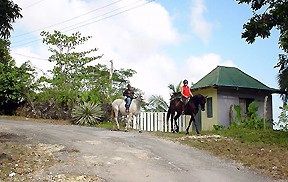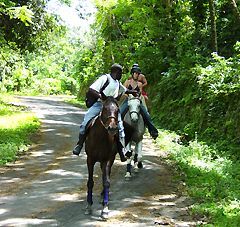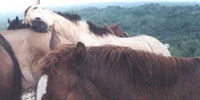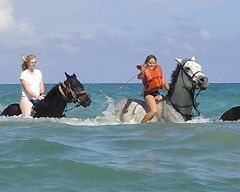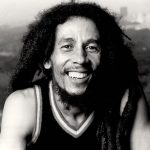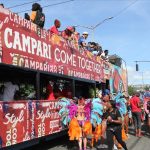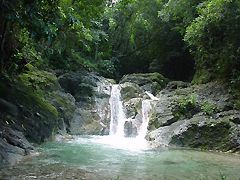
The History of the Horse in Jamaica
In 1493, Columbus brought on his second voyage, an animal that was to become one of the most significant contributors to the conquering of the New World, the horse. Spanish horses were regarded as particularly fine, with their noble heads, all-knowing eyes and high intelligence, 25 Andalusian horses were introduced to the Antilles. It is from this stock that the conquest of the New World began. In 1509 the first horses arrived in Jamaica with the settlers of “Sevilla La Nueva” (now the Maima/Seville Heritage Park).
The Tainos had never seen such a creature, it was an imposing and frightening sight for this peaceable culture to see a man mounted on a horse, it looked like man and beast had fused as one. They also believed that the horse was divine and feared that it fed on human flesh. Something that was promoted by the Spanish, who went out of their way to bury dead animals in order to promote the horses divinity and fear amongst the conquered people.
The Spanish settlers in Jamaica developed huge ranches and from the horses and donkeys that were brought over from Spain with the first settlers, started breeding mules. It was horses from Jamaica that the Spanish Conquistadores such as Cortez and Pizarro, took to the mainland. To quote one Conquistador “Horses are the most necessary things in the New Country because they frighten the enemy most, and after God to them belongs the victory!”
The Native Americans soon discovered the usefulness of the horse and adopted the horse into their “Plains Culture”. In fact it has been said by more than one Jamaican historian, had it not been for the horses bred and exported from Jamaica and the other Antillean islands, the mustang of America and whole wild west culture immortalized by Hollywood, would not exist!!!
As horses started to thrive on the American mainland, the necessity of the breeding stations soon became obsolete, and by 1545 shipments of these fine creatures were almost at a standstill. By this time the horses had multiplied to a point that when the English conquered the island in 1665, there were so many wild horses that they were considered as vermin.
The Sport of Horse Racing
The English introduced organized horse racing, which became very popular. The first races were held on the savanna west of the then capital Spanish Town. In a short space of time, every Parish had a racecourse, and races took place initially once per year. These races would continue over five or six days and there were Balls and Dances every night during the course of the race “season” for the fashionable “plantocracy”.
Racing in Kingston dates from 1783 when a racecourse was laid out to the north of the city, at what is now National Heroes Park. The course was over one mile or 1.6 km, and the purse was usually for 100 pounds sterling. In 1905, this course was moved to Knutsford Park and continued there until 1958 when it moved outside of the city limits to Caymanas Park and Knutsford Park was developed into New Kingston.
Before the introduction of the motorcar, almost every adult male owned a horse and there was always an element of friendly competition at social gatherings such as picnics when horses stamina and running ability were pitted against one another.
During the Plantation era, the best jockeys were usually slaves and Estate owners who continuously imported stallions and mares to improve their racing stock. Large stud farms soon developed during the 18th and 19th century in St Elizabeth and St Ann. Jamaican horses were also exported to build up the racing stock in Central American Countries.
Jamaican horses and racing personnel have made their mark overseas, and many horses bred on this fair island are exported to the islands of Barbados and Trinidad to improve their bloodstock lines. At any one given time, there are 2000 horses training for racing and race horses have become legends in song, such as the popular reggae tune “Long Shot kick the bucket”, immortalized by the Pioneers in 1968, about a horse who was far from a champion, but he had so much stamina and endurance that he ran 202 races, the most in local history, before dropping dead on the track.
Polo is Introduced to Jamaica
The sport of Polo was introduced to the island in 1882. Westerners, first saw a sport that originated in Persia 2,500 years ago, in the 19th century, when British soldiers, serving in Manipur, observed the national game. The Manipurs had copied and probably adapted the game from Tibet using the Tibetan name “pulu”. The British were establishing tea plantations in Manipur’s Cacher Valley, and five years later in 1859 the first European polo club was formed there. Polo came to Jamaica at about the same time when the sport was introduced to America.
There are three main Polo clubs, St Ann Polo Club, which is one of the oldest playing clubs in the Western Hemisphere, Chukka Cove and Kingston Polo Club. Matches can be seen during Polo season from April through August on Thursday and Saturday afternoons at any one of these polo clubs.
Equestrian Training and Leisure Riding
With the strong connection to the horse in Jamaica, it is hardly surprising to find several Equestrian Centres, where the finer arts of horsemanship are taught, and many trail riding operations where visitors and locals alike, can explore the beauty of the island from the back of a horse.
One such operation, found in the parish of St Ann is Hooves Ltd. Hooves has taken the concept of horseback riding one step further, by offering fully guided tours on horseback, visiting historical sites, such as Maima/Seville where the horse was first introduced to the island, into tropical rainforests and around spectacular mountaintops. Hooves allows their riders to enjoy the beauty of the spectacular scenery whilst learning about the multifaceted culture of the island. They also work with the rehabilitation of ex-racehorses, many of whom had been abused before coming into their care. These horses also make excellent candidates for their Equine Assisted Pyschotherapy programme, which has recently been introduced to the island. Horses have an innate way of mirroring the feelings and behavior traits of those working with them and as such are used in experiential therapy to help patients discover themselves.
For more information on Hooves and the services that they offer, check out their website at : www.hoovesjamaica.com.


